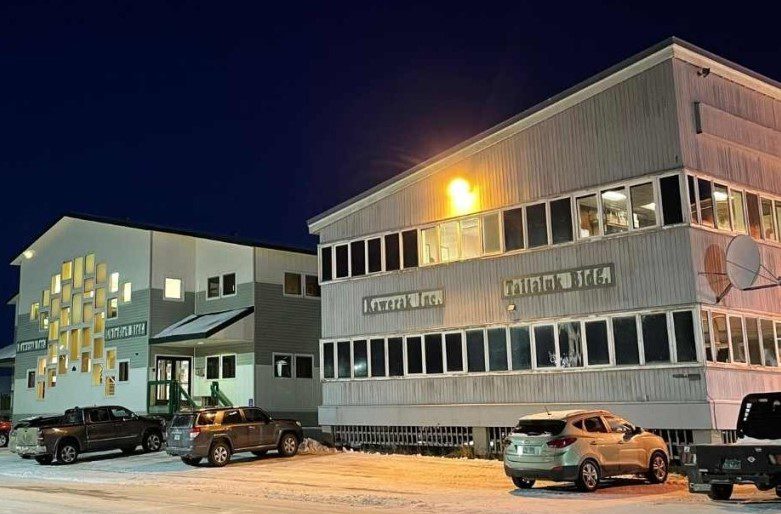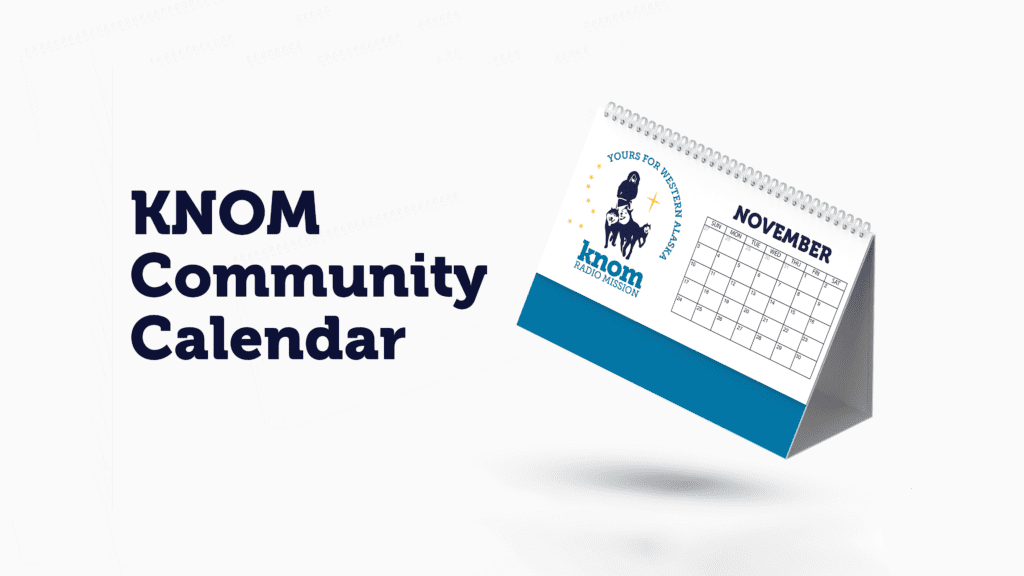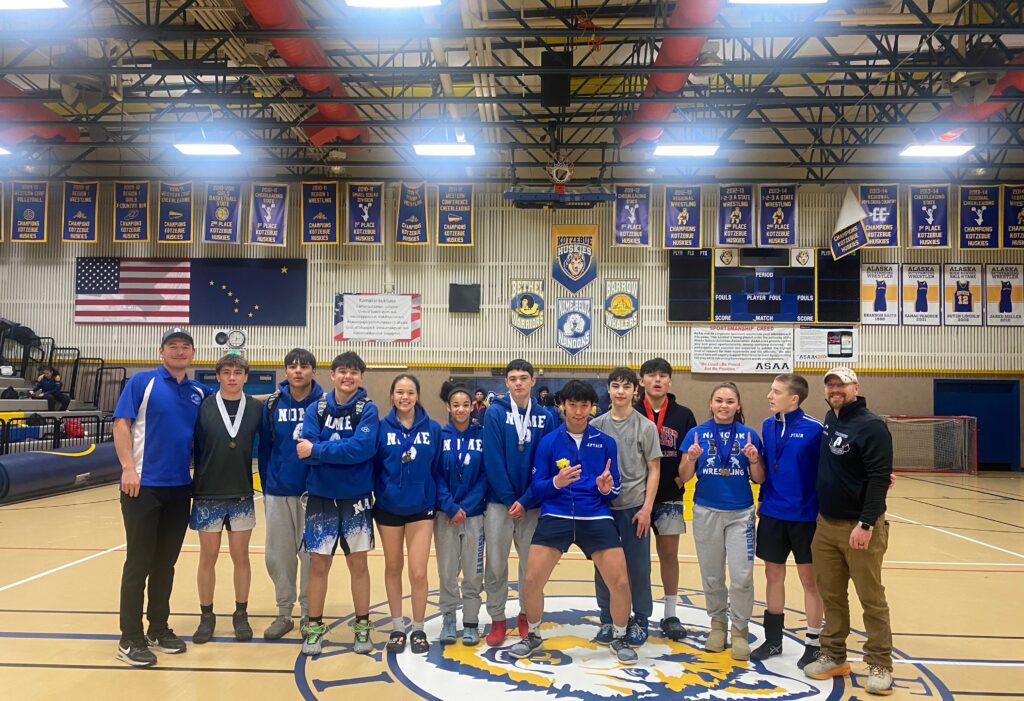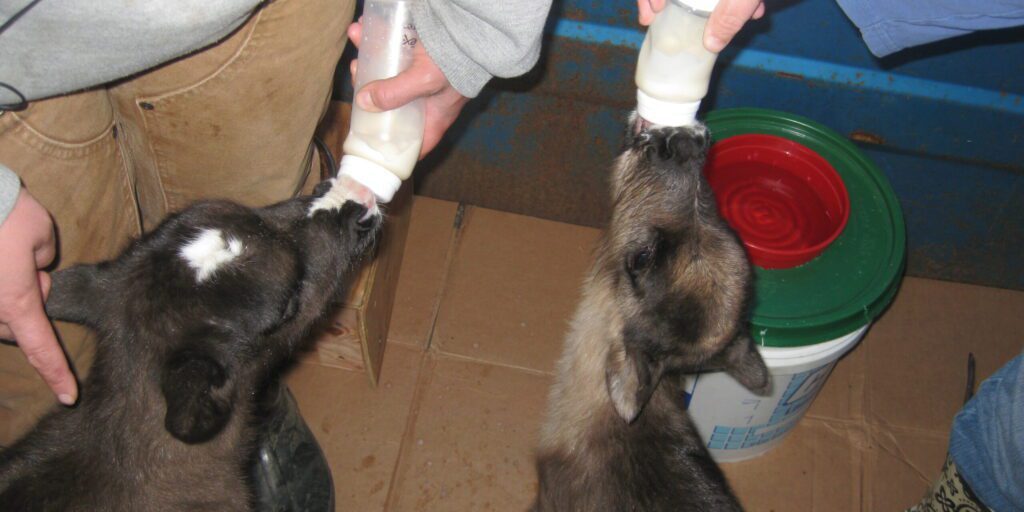“You’re doing something useful, you know,” began Bonnie Davis, daughter of reindeer herders Ann and Bruce Davis.
“You’re doing something that you know that’s going to make a difference. And you know we’re building towards for their grandkids, for my kids, for my cousins, for their cousins, for their kids. You know, we’re all…We’re all bringing our family back together.”
A few weeks ago, Ann and Bruce Davis found two orphaned reindeer fawns on their Davis Ranch— a girl, Brownie, and a boy, Blaze. Bonnie came up from Anchorage to help her parents with the new deer.
When I visited, the fawns were 15 days old. I arrived at feeding time.
Bonnie was preparing two bottles of milk, using a dry milk formula for young reindeer— Land of Lakes Pronurse.
Bonnie asked her Mom, “So you just make enough for a couple of feedings in this?”
“Yes,” said Ann.
“You make two cups,” said Bruce.
When the Davis’ first found Brownie and Blaze, they had to feed them every three hours.
When I asked Bruce what his life had been like over the last 15 days, he replied: “Hectic.”
Now that the fawns are bigger, they don’t have to be fed as often, because they can drink more per feeding.
Bruce said, “Now, we’ve got it where we give them between four and five ounces every six hours. So it’s a little bit better on our sleeping schedule.”
Bruce’s family owns the herd. He grew up with reindeer. In 2010 Ann and Bruce took over.
Around that time, the couple began taking a High Latitude Range Management Course. Another name for the class could be “How to be a Reindeer Herder.” The course is out of the University of Alaska Fairbanks, Northwest Campus in Nome. Bonnie is also in the program.
Bonnie and Ann took me out to feed the reindeer, milk bottles in hand. We could hear Blaze, the male fawn, honking.
“He’s very needy,” said Bonnie, laughing.
Ann agreed, “This one’s very needy.”
Then turning to Brownie, the female fawn, Ann said, “She’s a little fighter.”
Brownie was foraging, nibbling, and eating lichen. Ann said she took to the bottle right away. Blaze, on the other hand, was only drinking milk.
Foraging is important for the fawns, very important. It builds up the bacteria in their gut.
Bonnie said, “You can tell how well they’re doing, of course, by how they pee and they poo. And that’s why Mom’s concerned about him, because he’s still got runny poo.”
“And it’s runnier than it was,” said Ann.
She continued, “Their survival rate as orphans is pretty low, and every day that we can keep them going is an accomplishment until about 12 weeks. And then at 12 weeks, it’s almost a sure thing.”
Ann said the fawns were dropped and left by their moms. Basically, the herd moved on, and Brownie and Blaze got left behind. Ann said that’s not uncommon for first time moms.
“So we pick them up,” Ann said. “Otherwise, they become meals for the predators. And we found her (Brownie) just in time. There were ravens circling.”

The Davis’ plan to use the fawns as management tools.
“He’ll become a sled deer,” Ann explained. “And she will be a future lead female.”
In reindeer herds, the females are the leaders. So the idea is to tame Brownie; get her used to the Davis’; Brownie will follow Ann and Bruce; and the herd will follow Brownie.
“Hopefully, the other deer will emulate her,” said Bruce. “That she’s calm and that I’m not a stranger but the herdsman. And then we’ll bring them to the better feed areas.”
Ann and Bruce currently have 150 reindeer. But their range out by Banner Creek can hold up to 7,000.
“But we don’t want to get that big,” said Bruce. “Because we want to be able to have more control of the feeding areas and the animals. So we’re looking at 3 to 4,000.”
To reach that point, Bruce predicts it will take five to eight years.
I asked Bruce, “How important are these two to making that five-year plan happen?”
“It’s really important,” said Bruce. “It puts us on one-and-one with the animals.”
“So they’re kinda like your bridge to them?” I asked.
“Yes, it is,” said Bruce. He continued, “We’re in the reindeer herding business to be able to process meat, provide meat for our area. And that’s our goal.”
I visited the Davis’ last Friday. The next day, things took a turn.
“We had taken Blaze out to eat,” said Bruce, “have him browse with Brownie out there on the tundra. And we came back in, and he really didn’t eat no lichen out there on the tundra. He hasn’t eaten any lichen. So we brought him back in to give him milk. And he got into the box there and laid down. And he didn’t lay down like they normally do where he’s curled up. But he laid down flat. And then he…and then he passed away.”
It’s hard raising fawns in captivity. They need to be fed every few hours. They have commercial foods instead of their mother’s milk. And the fawns don’t have the example of other reindeer to follow to learn such basics as drinking water and eating lichen, a reindeer’s main food source.
I visited Ann and Bruce again. This time over breakfast. While Bruce and I talked, Ann sizzled sausage over the stove—reindeer sausage.
Bruce said, “Even though it’s difficult and it’s hard, we learned a lot.”
“How does Blaze being gone change your plans?” I asked.
“It doesn’t change our plans,” Bruce said. “We’re just going to continue on.”

Yesterday, Ann and Bruce graduated from the High Latitude Range Management Course and received their herding certificate. Ann said raising Brownie is like a final. Bonnie is still taking the class.
Before I left the ranch, I asked Bonnie, “Why is this what you’re all trying to do?”
Bonnie answered, “That feeling when you’re coming over the valley right there— that peaceful feeling— it extends when you’re doing this work. And you feel like you’re making a change. And we’re doing it for the next generation.”





